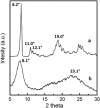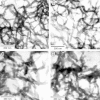Porous POSS-PANI nanofibre from interfacial polymerization and hydrothermal approach
- PMID: 26636020
- PMCID: PMC4659798
- DOI: 10.1186/s40064-015-1524-3
Porous POSS-PANI nanofibre from interfacial polymerization and hydrothermal approach
Abstract
Nowadays, novel applications for polyaniline (PANI) make new demands on its morphology controlling, and designing novel PANI or PANI composite polymeric materials has been more and more attractive. In this work, octaaminophenyl polyhedral oligomeric silsesquioxane (POSS) was employed to prepare nanostructured PANI composites via controlled fabrication. By interfacial copolymerization, fibrous nanostructure was obtained. The size and morphology of this structure was adjusted by changing POSS to OAPS ratio: the size increased from about 20 to 200 nm when the molar ratio of POSS in the composites increased from 0.5 to 2.0 mol %. More importantly, further hydrothermal treatment for the samples with higher POSS concentration resulted in mesoporous structure on a more microscopic scale, which helps to improve the thermal stability. In the total synthesis, POSS played an important role in the morphology controlling of the composites.
Keywords: Hydrothermal; Microstructure; Polymeric composites; Thermal properties.
Figures






References
-
- Agaskar PA, Klemperer WG. the higher hydridospherosiloxanes—synthesis and structures of hnsino1.5n (n = 12, 14, 16, 18) Inorgan Chim Acta. 1995;229:355–364. doi: 10.1016/0020-1693(94)04266-X. - DOI
-
- Anderson SE, Mitchell C, Haddad TS, Vij A, Schwab JJ, Bowers MT. Structural characterization of POSS siloxane dimer and trimer. Chem Mater. 2006;18:1490–1497. doi: 10.1021/cm052589c. - DOI
-
- Du XS, Zhou CF, Wang GT, Mai YW. Novel solid-state and template-free synthesis of branched polyaniline nanofibre. Chem Mater. 2008;20:3806–3808. doi: 10.1021/cm800689b. - DOI
-
- Dutt S, Siril PF. Morphology controlled synthesis of polyaniline nanostructures using swollen liquid crystal templates. J Appl Polym Sci. 2014;131:40800. doi: 10.1002/app.40800. - DOI
LinkOut - more resources
Full Text Sources
Other Literature Sources

